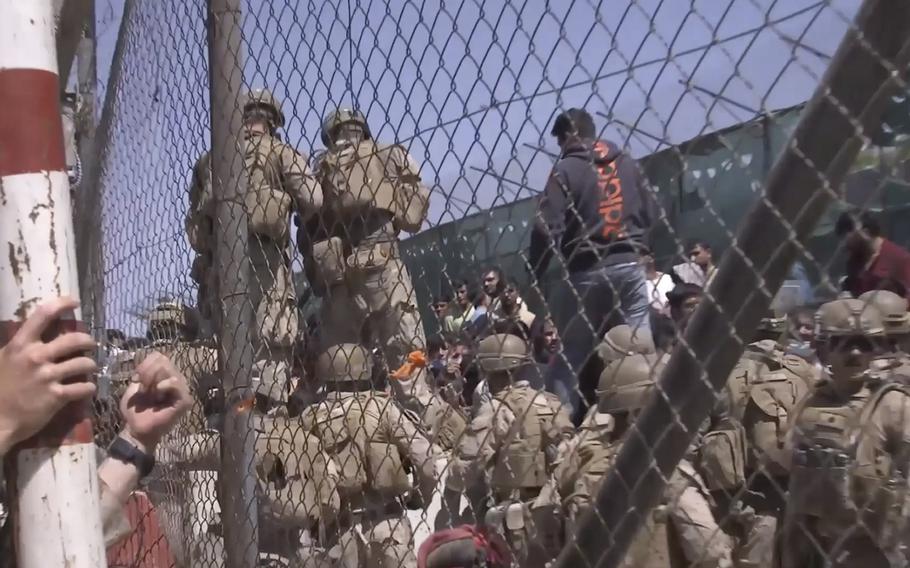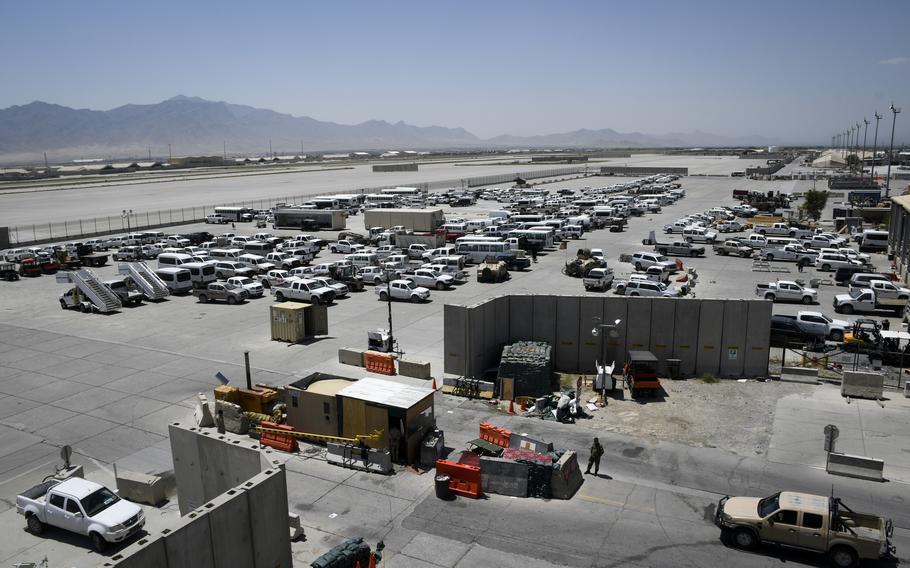
This image from a video released by the Defense Department shows U.S. Marines at Abbey Gate before a suicide bomber struck outside Hamid Karzai International Airport on Aug. 26, 2021, in Kabul Afghanistan. (Defense Department via AP)
The suicide attack in August 2021 outside the Kabul airport that killed dozens, including 13 American troops, would not have happened if the U.S. conducted its hasty withdrawal from Afghanistan from the larger Bagram airfield, a soldier told lawmakers Thursday.
Army Command Sgt. Maj. Jacob Smith told House lawmakers that Bagram’s larger, more rural footprint and its well-established defenses would have made the operation to withdraw tens of thousands of Americans, U.S. allies and Afghans safer. Smith, who remains on active duty as the senior enlisted leader of a 10th Mountain Division battalion, testified out of uniform Thursday before the House Foreign Affairs Committee’s subpanel on oversight and accountability to share his personal experiences during the pullout from Afghanistan.
“The events that happened at Abbey Gate, I believe that would not have occurred at Bagram,” Smith said about the Aug. 26, 2021, terrorist bombing at a Kabul airport entrance that killed more than 160 people. “The defenses that Bagram held [with] the ability to see for hundreds of meters and the defense in depth of its control points — I do not believe the result would have been the same.”
Smith served as the senior enlisted leader for the U.S. military’s Area Support Group-Afghanistan and as Bagram’s senior enlisted leader from October 2020 until he left Afghanistan for the final time July 2, 2021. As State Department leaders in 2021 planned the U.S. withdrawal, Smith said he had advised officials at the U.S. Embassy in Kabul to conduct evacuation operations out of Bagram over their other option, Hamid Karzai International Airport, or HKIA, in the middle of the Afghanistan capital.
Bagram was larger, better defended and had a more capable hospital and better equipment to destroy sensitive military gear that could not be removed from Afghanistan, Smith said he told State Department officials at the time.
“Bagram had a much more tactical advantage to conduct a [noncombatant evacuation operation] out of,” he said. “It was much easier to defend, the entry control points were very much defended in depth, and it would have been very easy to create a filtering process within those entry control points to filter out those that needed to be evacuated and those who didn't. It was just a much more tactically advantageous location.”
But American officials raised concerns about Bagram’s distance from the U.S. Embassy in Kabul, about 40 miles south, which they had initially planned to maintain. They also raised “personal comfort” issues on the sprawling base, Smith said.
He said he and Bagram leaders were ordered on June 14, 2021, to close the base by July 4. On July 2, he was one of the last conventional American troops to leave the base that U.S. forces had occupied for two decades.
“In hindsight, I have looked back and tried to identify any pragmatic rationale for using HKIA over Bagram,” Smith said Thursday. “The only answer I have identified is the ease of evacuees living in Kabul getting to the airfield. However, this course of action presented significant issues for anyone living outside of Kabul to get into the city. As Bagram was primarily surrounded by open terrain, it would have been overall easier to access by the general [Afghan] population of those evacuating.”
Republicans on the subpanel said Thursday that the decision to maintain HKIA over Bagram as the Taliban quickly advanced across Afghanistan amid the U.S. military pullout was one of dozens of poor decisions made by the State Department and President Joe Biden’s administration in the chaotic last weeks of the war. They lamented, nearly two years later, after several reviews of the events during and surrounding the withdrawal, no senior public officials had been held accountable for the decisions that led to the turbulent evacuation and the Taliban’s return to power.

Vehicles at Bagram airfield, Afghanistan, on July 7, 2021, days after U.S. troops left. The vehicles had been left for Afghan forces who took over the base. (J.P. Lawrence/Stars and Stripes)
“They're not taking responsibility,” said Rep. Mike Waltz, R-Fla., who served in Afghanistan as a Special Forces officer. “We will not let this go as long as I sit in this seat. We will drive accountability for” those killed in the Abbey Gate bombing and their families.
Waltz said the decision to conduct the evacuation out of HKIA was part of a pattern of Biden and other top officials ignoring the advice of military leaders.
Biden disagreed with the advice that he was given by his top generals overseeing the war in Afghanistan, who advised him shortly after entering office to maintain the U.S. military efforts in the country, despite the Doha agreement struck between the Taliban and former President Donald Trump. That accord called for American troops to leave Afghanistan in spring 2021. Biden extended America’s military presence until Sept. 11, 2021, but that timeline was ultimately sped up as the Taliban marched on Kabul and Afghan President Ashraf Ghani fled the country on Aug. 15.
Ret. Army Col. Seth Krummrich, who was serving as the chief of staff for U.S. Special Operations Command-Central during the withdrawal, told committee members Thursday that Army Gen. Mark Milley, chairman of the Joint Chiefs of Staff, now retired Marine Gen. Kenneth McKenzie, then the commander of U.S. Central Command, and Army Gen. Austin Miller, the final top U.S. commander in Afghanistan, had advised Biden that the Taliban had not lived up to the Doha agreement, and he should maintain troops there.
Biden, nonetheless, has said he was committed to ending the war.
“These seasoned experts were ignored, and the best-case scenario plan to withdraw immediately started the domino effect to catastrophe,” said Krummrich, a former Special Forces officer who was among the first American troops in Afghanistan in 2001. “There was no time for traditional military planning, to include looking at worst-case scenarios in real detail. … Prudence and patience were replaced by speed of action without the time to study the consequences and mitigate those risks. The bottom line is the administration controlled how we withdrew and when we withdrew, making them the majority stakeholder of many guilty parties in the failure and collapse of Afghanistan and the current Taliban rule.”
The White House has long defended the evacuation as an operational success, given that 120,000 people were evacuated from the small airport surrounded by Taliban fighters. A State Department report published last month blamed errors by the Biden and Trump administrations for leading to the deadly withdrawal and the Taliban’s takeover of the country.
Democrats on Thursday defended Biden’s decision to withdraw as a necessary one under tough circumstances given the agreement forged by Trump. The Trump administration declined to brief Biden officials on that status of the war or the agreement ahead of the presidential transition in January 2021, while Trump refused to admit he had lost the election.
The Biden administration “walked in knowing nothing, having no transition, having no briefings, no plans in place, and they embarked on a two-month process to try to get their hands around the issue and figure out what was going on [in Afghanistan],” said Rep. Jason Crow, D-Colo., the subpanel’s top Democrat, who served in Afghanistan as an Army Ranger officer. “Then they made the decision to abide by the agreement because we had very few troops there. We were being told and the intelligence was showing that the Taliban was going to start attacking us again, if we didn't withdraw on time.”
Crow said if Biden had decided to maintain American troops in Afghanistan, they were going to be forced to “fight harder than we would have had to have fought for years.”
“Our soldiers would have been fighting and dying then, too,” he said. “Tough decisions.”
The Democrat said U.S. officials should focus on learning from the mistakes made throughout the Afghanistan war and during the withdrawal.
Ret. Army Col. Christopher Kolenda, another Afghanistan war veteran who testified before the panel on Thursday, said the chaotic withdrawal was the latest in a long pattern of problematic evacuations at the end of American wars. He listed the withdrawal from Vietnam and the 2011 withdrawal from Iraq as other examples of poor planning in ending wars. Just three years after U.S. troops left Iraq, they were forced to return to help fight the Islamic State, which had conquered much of the country. Some 2,000 American forces remain there today.
Kolenda said the United States must better define its national security objectives and definitions for ending wars and create documents with expert knowledge on the subject to refer to the next time the United States seeks to close out a war.
“We need to have a doctrine about war termination,” said Kolenda, who participated as a civilian in negotiations with the Taliban. “The military doesn't have one. The State Department doesn't have one. State Department's got no expert body of knowledge on how to conduct wartime negotiations in which the United States is the active participant, and it has not worked out well every single time.”
Kolenda also suggested the president should designate a single individual in charge of all government efforts around a war, either a civilian or military official. Top military commanders now only oversee the efforts of the armed forces, while other parts of a war from diplomatic to intelligence operations are overseen by other leaders.
He suggested lawmakers should consider crafting legislation to create such a position to better hold leaders accountable for wartime efforts.
“The senior leaders [of different organizations] on the ground — the lowest-ranking person that they all report to is the president of the United States,” Kolenda said. “I mean, you can't run a business that way. You certainly can't run a war that way.”